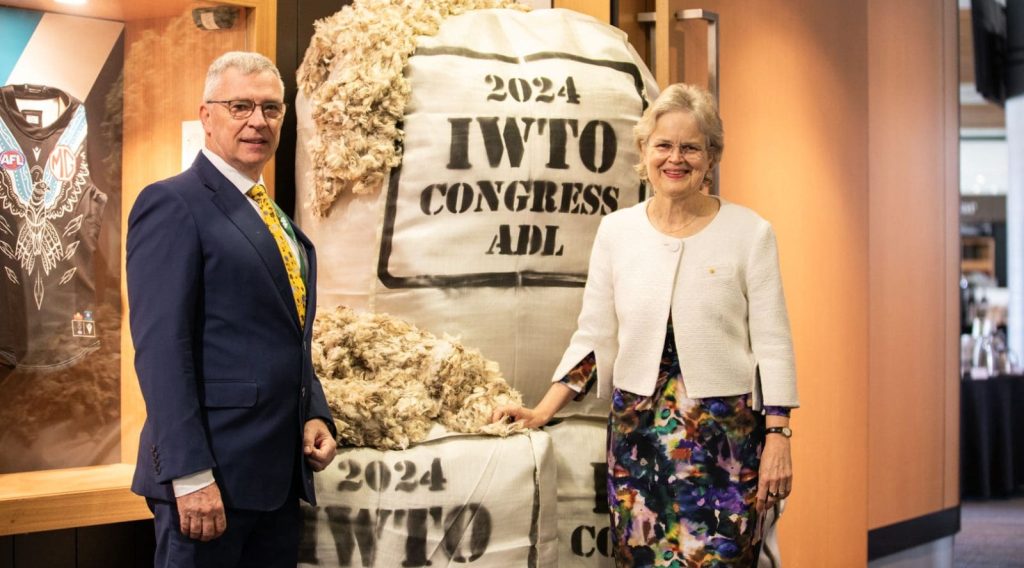
Wool Industries Australia president David Michell with South Australian Governor Frances Adamson, who opened the IWTO Congress in Adelaide last week.
AUSTRALIA’S proposed wool traceability hub is aiming to achieve mandatory Property Identification Code declaration by all wool growers to facilitate an efficient emergency animal disease response.
At the International Wool Textile Organisation Congress in Adelaide last week, AWTA managing director Michael Jackson said the need for Australia’s wool industry to prepare for an EAD response is the primary driver and immediate priority of the proposed Australian Wool Traceability Hub.
“If Australia ever had an exotic animal disease outbreak, responding to it quickly and efficiently is critical.
“We must learn the lessons from our South African and UK customers,” he said.
“The traceability system will not eliminate trade disruption should a disease such as Foot and Mouth Disease occur, but an effective and integrated traceability system will help minimize the length of that disruption.
“We need to very quickly know all about wool shorn on the farms in disease affected areas.”

AWTA managing director Michael Jackson – heading hub discussions. Image – AWTA.
Mr Jackson said Australia has legislated systems to track the movement of farm animals for EAD purposes and all farmers have a PIC or Property Identification Code.
“It makes sense to the wool industry to use the same PIC to identify the property on which the wool is grown.”
Mr Jackson said brokers and private merchants started providing the PIC to AWTA to record in a central database on a voluntary basis about 18 months ago.
“The uptake was rapid with PICs now recorded for over 50 percent of the wool clip, although it has now plateaued at that level.
“It really needs to be 100 percent to allow vets and regulators, both in Australia and in importing countries, to have confidence that any EAD response is comprehensive,” he said.
Mr Jackson said certainly the hub’s intention is to get declaration of the PIC to be mandatory.
“The issue is how do you go about doing that.
He said one approach would by legislation, as per electronic identification sheep tags.
“I don’t think anyone in the industry wants to invite more regulation from government…..
“We’ve been having some active discussion already about an industry approach to that; what are the tools we could do it through an industry-supported code of practice,” Mr Jackson said.
“I think there is every chance that the way we are looking at going and I’m not going to tell you what it is yet, because I don’t think it would be productive to do that.
“But I would expect from IWTO’s point of view that this group will be back to IWTO next year with some suggestions in that regard.”
Provenance data is of increasing importance
Mr Jackson said the Australian wool industry also knows that provenance is increasingly important to its overseas customers.
“Brands, retailers, customers, increasingly want to know where the raw materials come from and the conditions on the farm.
Regulators, particularly in Europe, are driving sustainability and environmental issues….,” he said.
“Improving traceability is becoming non-negotiable to maintain market access.”
Mr Jackson said information is already passed along the wool chain with AWTA test certificates, by exporters and an increasing number of integrity schemes.
“We see that demand for information will only increase in coming years and you’ve just got to think about the carbon discussions we’ve been having.
“A collaborative approach is needed to minimize duplication and facilitate the flow of that information alongside the physical wool bales,” he said.
“Having an industry-managed hub which ensures that high integrity data is available in the most efficient way possible is critical for Australian wool.”
Mr Jackson said the initial plan is for the hub to address the EAD response first and foremost.
“However, it must be designed and built with an eye to the future so that it can expanded efficiently to carry commercially relevant information from growers through to exporters and processors.
“Eventually we see the AWTH as a whole of industry data hub connecting other traceability tools to provide in-demand information about Australian wool.”
Wool Industries Australia to oversee hub
Mr Jackson said a WoolProducers traceability study in 2021 concluded that commercial traceability systems had served their purposes, but had not kept up with increasing biosecurity risk nor consumer expectations and industry needed to take a collaborative approach to develop an integrated and effective traceability system, avoid duplication.
“It needed to improve integrity and efficiency by replacing paper and manual systems with a modern approach.”
The hub concept to date has been developed with input from Australian Wool Innovation, AWTA, the National Council of Wool Brokers of Australia, the Australian Council of Wool Exporters and Processors and WoolProducers Australia.
Mr Jackson said Wool Industries Australia will now oversee further development of the hub as its steering committee and AWTA has been identified as the industry organisation best placed to manage the hub.
“This ensure that we maintain an all-of-industry approach.”
He said the hub will collect relevant information, starting on farm and adding to it as the wool is transported, tested, sold and shipped.
“Initially the focus will be on the PIC to allow a robust EAD tool to be established.
“Other first priority data will include that already routinely used to trade wool, test certificates and shipping documents.”
Mr Jackson said integrity scheme certificates or other on-farm practices will be considered in subsequent developments.
“If possible that information will be validated and any declared information will be clearly identified as such.
“To be absolutely clear, the hub is not an integrity scheme … the hub will not compete in this space; nit will be prepared to work with those schemes to carry their certificates if that improves industry efficiency,” he said.
“We’re planning a feature that will allow exporters to use the hub to make information about the wool available to a first stage processor … the hub will not proceed to trace the wool further down the supply chain, for example, through the top makers, spinners, weavers.
“What it will be is become an input for other traceability schemes or block chains that operate further down the supply chain after the wool is removed from its pack for scouring.”
Who will have access to hub data?
AWTA chief information officer Nick Ignatenko said the official launch of the hub is scheduled for July this year, with 30pc of buyers and sellers ‘onboarded’, with a second phase of functionality delivered by December, with the target of more than 90pc of wool bales able to be traced by July 2025.
AWN John Colley congratulated the hub group on the long overdue development and asked who would have access to the data along the chain.
Mr Ignatenko said “this (EAD) application is under the entire management of AWTA”, supported by AWI in development.
“The data, to be more specific is owned by the people who provide it, that, let’s call it the provenance of that data is still with the providers.
“We have a lot of opt-in, opt-out scenarios, but the availability of the data ongoing is through AWTA … very restricted, only to AWTA.
“We will put some strict controls in for that to happen and we’ll provide access to the chief veterinary officers under regulation when it’s required as well.”
Mr Jackson said from a provenance point of view the ownership of the data is being modelled very closely on how test certificate data is treated.
“And that is, the broker pays us for it, when the broker transfers the wool to the exporter they transfer the certificate to the exporter.
“The exporter then, depending on their contractual arrangements with whoever is buying that wool from them will transfer those certificates along the way,” he said.
“Those people will be the ones who control who has access to that data, so it will be the same arrangements that everyone in this room is familiar with from a test certificate point of view currently.”
Wool grower Cathy Hayne said growers should be able to know who has their data.
“At the moment we can’t trace beyond who has bought it in the auction room and I think it is very important that the grower knows who has that data.”
Mr Jackson said there will be a hub functionality for that, but that would be subject to the people who have requested a test certificate to enact that.
“Whomever has requested the AWTA to do a test will have the ability to effectively liven that tick-a-box which then the grower would be able to trace their wool as it goes through to the processor.
“So there is certainly consideration of that providing we respect those commercial arrangements.”
ACWEP president Josh lamb said it’s hard for exporters moving hundreds of thousands of bales a year to provide that information back to a grower, but hopefully the hub will be able to do it in a digital form and helps growers improve what they do on farm.
“There is things this hub will do that we haven’t even thought about yet, it’s fantastic to have something like this to help us face the challenges that will come the industry’s way in the future.”

HAVE YOUR SAY